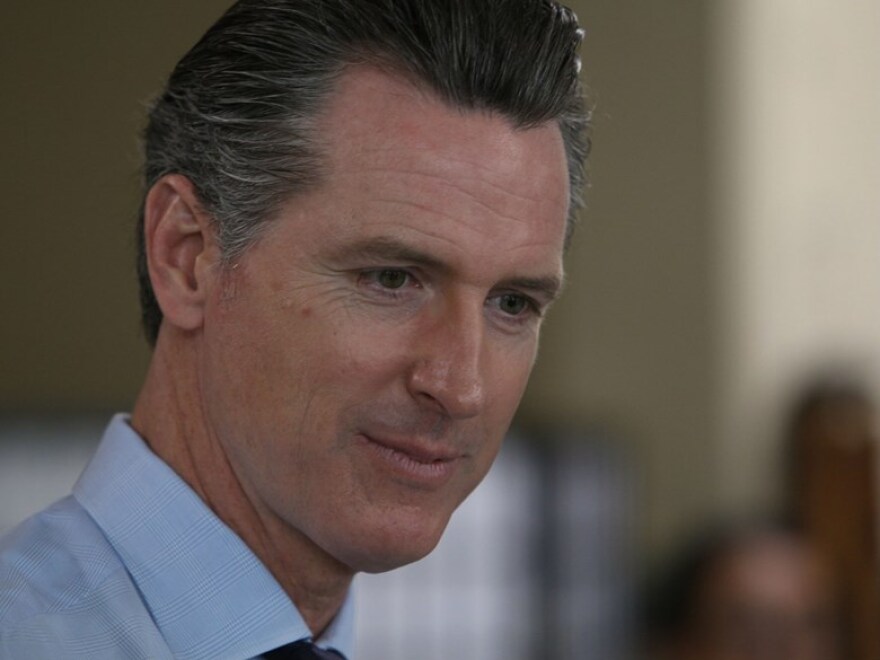Gavin Newsom, the 51-year-old Democrat who has eyed California’s top office for the past decade and is promising sweeping new statewide programs as part of a full-throated resistance to President Donald Trump, will be the state’s 40th governor.
Newsom will succeed Democrat Jerry Brown, who departs the governor’s office in January after a record four terms. Brown also held the job from 1975-83 before voters approved term limits.
The lieutenant governor and former San Francisco mayor will inherit a state that looks nothing like the one Brown faced when he began his second stint in office in 2011. Back then, California faced a $27 billion deficit. Now, the state is projected to end the current fiscal year next summer with $16 billion in reserves — all while its general fund budget has soared 60 percent higher.
Yet the state’s cost of living has also soared — and California’s poverty rate is the highest of any state. According to the U.S. Census Bureau’s Supplemental Poverty Measure, which factors in cost-of-living, California’s three-year average poverty rate from 2015-17 was 19 percent.
Newsom and Cox both campaigned on fighting poverty — but with very different policy prescriptions. Newsom has promised sweeping new government programs, including universal pre-school and single-payer health care, to help families struggling to make ends meet. Cox says he would cut taxes and reduce regulations to speed up construction projects.
Newsom has long struggled to fight his reputation of being a glamorous San Francisco socialite whose business and political careers were jump-started by wealthy and connected families. He was, however, raised by a single mom who worked multiple jobs. He also battled what he describes as “pretty severe” dyslexia.
()
Legendary San Francisco Mayor Willie Brown gave Newsom his political break with an appointment to a city commission in 1996, and to a vacated county supervisor seat the following year. That positioned him to run for mayor — and win — in 2003. He led the city until being sworn in as lieutenant governor in 2011.
Although possibly best known as the mayor who married same-sex couples years before courts declared them legal, Newsom earned a reputation at City Hall as a business-friendly moderate — albeit in a city famously known for its liberal politics.
As lieutenant governor, however, and with a run for governor long on his mind, Newsom led statewide ballot measures that tightened gun control and legalized recreational marijuana. And on the campaign trail, he has declared himself a strong supporter of single-payer health care — though he later said he is open to universal coverage that does not include single-payer.
Newsom’s second run for governor turned out far more successful than his first. He entered the 2010 Democratic primary in April 2009 but dropped out months later as polls showed him far behind Brown.
Then, barely a month after Brown was sworn in for his record fourth term in early 2015, Newsom declared he would run to succeed him.
That unprecedented early entrance paid off — literally. By the end of 2016, when rivals in both parties were getting into — or bowing out of — the governor’s race, Newsom had already stockpiled more than $10 million.
He never relinquished the frontrunner status he claimed back in February 2015, leading both in fundraising and in every credible poll during his wire-to-wire victory.
Indeed, the biggest challenge Newsom faced came not from a candidate, but rather an independent expenditure group run by the political arm of the state’s charter school association on behalf of former Los Angeles Mayor Antonio Villaraigosa ahead of California’s June 5 primary election.
The effort raised more than $20 million from wealthy donors, including Netflix CEO Reed Hastings and former New York City Mayor Michael Bloomberg. But the group put most of that money toward ads that promoted Villaraigosa — instead of attacking Newsom, Cox, or state Treasurer John Chiang, another Democrat who had mounted a multimillion-dollar TV ad campaign.
Newsom and his allies, meanwhile, settled on Cox as their preferred general election candidate. They believed Newsom’s path to victory in November would be far smoother against a Republican than a more moderate Democrat such as Villaraigosa or Chiang. So they worked to build up Cox’s name recognition among Republicans by running TV ads attacking him.
Cox also benefited from Trump’s personal endorsement, which came in a mid-May tweet shortly after voting by mail had begun for the June primary. That helped him pull ahead of his lone GOP primary rival, Orange County Asm. Travis Allen — even though Allen had voted for Trump in the 2016 presidential election while Cox had voted for libertarian candidate Gary Johnson.
Newsom and Cox finished well ahead of their opponents in June, with 34 and 25 percent, respectively. Villaraigosa came in third with 13 percent, Allen and Chiang followed with just under 10 percent, and former state schools superintendent Delaine Eastin, another Democrat, finished last among the six candidates who shared a primary debate stage with 3 percent.
Copyright 2018 Capital Public Radio



